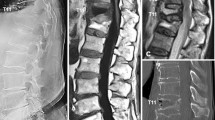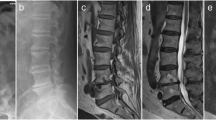Abstract
Reports have detailed the increasing use of spinal instrumentation in the treatment of pyogenic vertebral osteomyelitis, with the aims of achieving a lower pseudoarthrosis rate and restoring spinal alignment. However, controversy remains over the use of instrumentation in the presence of active infection because of concerns about increased bacterial adherence and biofilm formation on the metallic implant surface. Fourteen consecutive patients were followed who were diagnosed as having pyogenic vertebral osteomyelitis and underwent surgery with spinal instrumentation with iodine-containing surfaces that could be directly supported to existing titanium implants. Bone–cage interfaces and implant-related complications after surgery were evaluated. The white blood cell (WBC) count and C-reactive protein (CRP) level were analyzed during the follow-up period. To confirm the influence of iodine release from the implant, thyroid-stimulating hormone (TSH), free triiodothyronine (FT3), and free thyroxine (FT4) were also examined. The infection subsided in all 14 patients. Both WBC counts and CRP levels returned to normal ranges by the final follow-up. One patient showed a lucent area around the screw and two patients showed lucencies inside the cage. However, no cage dislocations, cage migrations, or screw pull-outs were noted, and all patients’ FT3, FT4, and TSH levels were within normal ranges during the follow-up period. We demonstrated the efficacy of iodine-supported titanium implants in the management of pyogenic vertebral osteomyelitis. No cytotoxicity or adverse effects were noted in this series.





Similar content being viewed by others
References
Jevtic V (2004) Vertebral infection. Eur Radiol 14:E43–E52
Cheung WY, Luk KD (2012) Pyogenic spondylitis. Int Orthop 36:397–404. doi:10.1007/s00264-011-1384-6
Rezai AR, Woo HH, Errico TJ, Cooper PR (1999) Contemporary management of spinal osteomyelitis. Neurosurgery 44:1018–1026
Jensen AG, Espersen F, Skinhøj P, Rosdahl VT, Frimodt-Møller N (1997) Increasing frequency of vertebral osteomyelitis following Staphylococcus aureus bacteraemia in Denmark 1980–1990. J Infect 34:113–118
Grammatico L, Baron S, Rusch E, Lepage B, Surer N, Desenclos JC et al (2008) Epidemiology of vertebral osteomyelitis (VO) in France: analysis of hospital-discharge data 2002–2003. Epidemiol Infect 136:653–660
Hee HT, Majd ME, Holt RT, Pienkowski D (2002) Better treatment of vertebral osteomyelitis using posterior stabilization and titanium mesh cages. J Spinal Disord Tech 15:149–156
Liljenqvist U, Lerner T, Bullmann V, Hackenberg L, Halm H, Winkelmann W (2003) Titanium cages in the surgical treatment of severe vertebral osteomyelitis. Eur Spine J 12:606–612
Korovessis P, Repantis T, Iliopoulos P, Hadjipavlou A (2008) Beneficial influence of titanium mesh cage on infection healing and spinal reconstruction in hematogenous septic spondylitis: a retrospective analysis of surgical outcome of twenty-five consecutive cases and review of literature. Spine 33:E759–E767. doi:10.1097/BRS.0b013e318187875e
Ha KY, Chung YG, Ryoo SJ (2005) Adherence and biofilm formation of Staphylococcus epidermidis and Mycobacterium tuberculosis on various spinal implants. Spine (Phila Pa 1976) 30:38–43
Tsuchiya H, Shirai T, Nishida H, Murakami H, Kabata T, Yamamoto N et al (2012) Innovative antimicrobial coating of titanium implants with iodine. J Orthop Sci 17:595–604. doi:10.1007/s00776-012-0247-3
Shirai T, Shimizu T, Ohtani K, Zen Y, Takaya M, Tsuchiya H (2011) Antibacterial iodine-supported titanium implants. Acta Biomater 7:1928–1933. doi:10.1016/j.actbio.2010.11.036
Shirai T, Tsuchiya H, Shimizu T, Ohtani K, Zen Y, Tomita K (2009) Prevention of pin tract infection with titanium–copper alloys. J Biomed Mater Res B Appl Biomater 91:373–380. doi:10.1002/jbm.b.31412
Hashimoto K, Takaya M, Maejima A, Saruwatari K, Hirata M, Toda Y et al (1999) Antimicrobial characteristics of anodic oxidation coating of aluminum impregnated with iodine compound. Inorg Mater 6:457–462 (in Japanese)
Hadjipavlou AG, Mader JT, Necessary JT, Muffoletto AJ (2000) Hematogenous pyogenic spinal infections and their surgical management. Spine (Phila Pa 1976) 25:1668–1679
Osenbach RK, Hitchon PW, Menezes AH (1990) Diagnosis and management of pyogenic vertebral osteomyelitis in adults. Surg Neurol 33:266–275
Sapico FL, Montgomerie JZ (1979) Pyogenic vertebral osteomyelitis: report of nine cases and review of the literature. Rev Infect Dis 1:754–776
Eismont FJ, Bohlman HH, Soni PL, Goldberg VM, Freehafer AA (1983) Pyogenic and fungal vertebral osteomyelitis with paralysis. J Bone Joint Surg Am 65:19–29
McHenry MC, Easley KA, Locker GA (2002) Vertebral osteomyelitis: long-term outcome for 253 patients from 7 Cleveland-area hospitals. Clin Infect Dis 34:1342–1350
Chen WH, Jiang LS, Dai LY (2011) Influence of bacteria on spinal implant-centered infection: an in vitro and in vivo experimental comparison between Staphylococcus aureus and mycobacterium tuberculosis. Spine (Phila Pa 1976) 36:103–108. doi:10.1097/BRS.0b013e3181cb46ba
Yilmaz C, Selek HY, Gürkan I, Erdemli B, Korkusuz Z (1999) Anterior instrumentation for the treatment of spinal tuberculosis. J Bone Joint Surg Am 81:1261–1267
Oga M, Arizono T, Takasita M, Sugioka Y (1993) Evaluation of the risk of instrumentation as a foreign body in spinal tuberculosis. Clinical and biologic study. Spine (Phila Pa 1976) 18:1890–1894
Shirai T, Watanabe K, Matsubara H, Nomura I, Fujiwara H, Arai Y et al (2014) Prevention of pin tract infection with iodine-supported titanium pins. J Orthop Sci 19:598–602
Bosetti M, Massè A, Tobin E, Cannas M (2002) Silver coated materials for external fixation devices: in vitro biocompatibility and genotoxicity. Biomaterials 23:887–892
Gosheger G, Hardes J, Ahrens H, Streitburger A, Buerger H, Erren M et al (2004) Silver-coated megaendoprostheses in a rabbit model—an analysis of the infection rate and toxicological side effects. Biomaterials 25:5547–5556
Massè A, Bruno A, Bosetti M, Biasibetti A, Cannas M, Gallinaro P (2000) Prevention of pin track infection in external fixation with silver coated pins: clinical and microbiological results. J Biomed Mater Res 53:600–604
Hardes J, von Eiff C, Streitbuerger A, Balke M, Budny T, Henrichs MP et al (2010) Reduction of periprosthetic infection with silver-coated megaprostheses in patients with bone sarcoma. J Surg Oncol 101:389–395. doi:10.1002/jso.21498
Financial support
None.
Conflict of interest
The authors declare that they have no conflict of interest.
Author information
Authors and Affiliations
Corresponding author
Rights and permissions
About this article
Cite this article
Demura, S., Murakami, H., Shirai, T. et al. Surgical treatment for pyogenic vertebral osteomyelitis using iodine-supported spinal instruments: initial case series of 14 patients. Eur J Clin Microbiol Infect Dis 34, 261–266 (2015). https://doi.org/10.1007/s10096-014-2226-4
Received:
Accepted:
Published:
Issue Date:
DOI: https://doi.org/10.1007/s10096-014-2226-4




